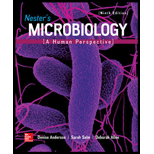
Nester's Microbiology: A Human Perspective
9th Edition
ISBN: 9781259709999
Author: Denise G. Anderson Lecturer, Sarah Salm, Deborah Allen
Publisher: McGraw-Hill Education
expand_more
expand_more
format_list_bulleted
Textbook Question
Chapter 20, Problem 1SA
Describe the difference between the terms antibiotic and antimicrobial.
Expert Solution & Answer
Summary Introduction
To review:
The difference between antibiotic and antimicrobial.
Introduction:
Antimicrobials and antibiotics are substances that inhibit the growth or kill the pathogens that cause infection in the body. They might be confused by people as substances belonging the same category, but they are different.
Explanation of Solution
Difference between antimicrobials and antibiotics-
| Antimicrobials | Antibiotics |
| The term antimicrobials refer to any substance that inhibits the action of microorganisms or kill them, with almost imparting no damage to the host. | The term antibioticsrefer to the products of microorganisms that kill the other microorganisms |
| Antimicrobials have a broad range. | Antibiotics have a narrow range. |
| Antimicrobials can perform the function of antibiotics too. | Antibiotics cannot perform the task of antimicrobials. |
| For example, salvarson. | For example, penicillin G. |
Conclusion
Therefore, it can be concluded that antibiotics are a part of antimicrobials but all antimicrobials are not antibiotics.
Want to see more full solutions like this?
Subscribe now to access step-by-step solutions to millions of textbook problems written by subject matter experts!
Students have asked these similar questions
not use ai plesea
(A) 25
20
20
15
NPP (Mg C/ha/yr)
10
10
5
0
0
2,000
4,000
6,000
ECOLOGY 4e, Figure 20.11 (Part 1)
2017 Sinauer Associates, Inc.
Average annual precipitation (mm)
8,000
explain the cascade of events (starting with relaxing trade winds) that occurs during El Niño in the eastern Pacific (off the coasts of California/North America and Peru/South America) and which lead to food-chain collapse
- start with changes in the physical/oceanographic conditions, andthen systematically describe the cascading effects at each level of the food chain
-
Chapter 20 Solutions
Nester's Microbiology: A Human Perspective
Ch. 20 - Describe the difference between the terms...Ch. 20 -
2. Define therapeutic index and explain its...Ch. 20 -
3. Explain how penicillin-binding proteins (PBPs)...Ch. 20 - Name three classes of antimicrobial medications...Ch. 20 - Explain the roles of the first-line drugs versus...Ch. 20 -
6. Compare and contrast the method for...Ch. 20 - Name three targets that can be altered...Ch. 20 - What is MRSA? Why is it significant?Ch. 20 - Prob. 9SACh. 20 -
10. Explain the difference between the mechanism...
Ch. 20 - Which of the following targets would you expect to...Ch. 20 -
2. Penicillin has been modified to make...Ch. 20 -
3. Which of the following is the target of...Ch. 20 -
4. Which of the following statements is false?
a)...Ch. 20 - Prob. 5MCCh. 20 - Prob. 6MCCh. 20 - Prob. 7MCCh. 20 - Prob. 8MCCh. 20 - Prob. 9MCCh. 20 - Prob. 10MCCh. 20 - Prob. 1ACh. 20 - Prob. 2ACh. 20 - Prob. 1CTCh. 20 - Prob. 2CT
Knowledge Booster
Learn more about
Need a deep-dive on the concept behind this application? Look no further. Learn more about this topic, biology and related others by exploring similar questions and additional content below.Similar questions
- 3) Which statement(s) about the Pacific Decadal Oscillation (PDO) is/are TRUE? CIRCLE ALL THAT APPLY. A. It is a major driver of salmon populations in the Pacific B. It affects sea surface temperatures in the eastern Pacific C. Its cycles typically do not last as long as those of ENSO D. Evidence that it has occurred over many centuries has been gathered from tree ring dataarrow_forward4.arrow_forward2arrow_forward
- 1. 2. 3. Marine fish cells are hypotonic compared to their seawater environment; their cells lose water by osmosis and gain solutes. If you add heterotrophic respiration and autotrophic respiration together and then subtract that value from gross primary productivity, then you have a more refined estimate of ecosystem carbon storage than NEE. Differential heating due to the earth's tilt generates the global wind AND oceanic circulation patternsarrow_forward1arrow_forwardCan you please simply explain what is going on here.arrow_forward
- Does it show the level of proteins? What about the amount? Levels of protein activation? How can you tell? Does the thickness tell you anything? What about the number of the lines? And the other questionsarrow_forwardKD 200- 116- 66- Vec ATF6 (670) ATF6 (402) ATF6 (373) ATF6 (366) I I 45- 1 2 3 4 5 ATFG (360) (e/c) 9V ATFG (402) g ant- ATF anti-KDEL DAPI barrow_forwardWestern blot results: what information can you get? Presence of proteins of your interest Levels of protein expression Levels of protein activation (must use activation state-specific antibody) Decreased function of the ATM kinase in aging mice. A C57BL/6 female 6 month Con IR 20 month C57BL/6 male 6 month 28 month Con IR Con IR Con IR p-ATM (S1981) ATM P-p53 (ser18) Actinarrow_forward
arrow_back_ios
SEE MORE QUESTIONS
arrow_forward_ios
Recommended textbooks for you
- Essentials of Pharmacology for Health ProfessionsNursingISBN:9781305441620Author:WOODROWPublisher:Cengage
 Comprehensive Medical Assisting: Administrative a...NursingISBN:9781305964792Author:Wilburta Q. Lindh, Carol D. Tamparo, Barbara M. Dahl, Julie Morris, Cindy CorreaPublisher:Cengage Learning
Comprehensive Medical Assisting: Administrative a...NursingISBN:9781305964792Author:Wilburta Q. Lindh, Carol D. Tamparo, Barbara M. Dahl, Julie Morris, Cindy CorreaPublisher:Cengage Learning Principles Of Radiographic Imaging: An Art And A ...Health & NutritionISBN:9781337711067Author:Richard R. Carlton, Arlene M. Adler, Vesna BalacPublisher:Cengage Learning
Principles Of Radiographic Imaging: An Art And A ...Health & NutritionISBN:9781337711067Author:Richard R. Carlton, Arlene M. Adler, Vesna BalacPublisher:Cengage Learning

Essentials of Pharmacology for Health Professions
Nursing
ISBN:9781305441620
Author:WOODROW
Publisher:Cengage




Comprehensive Medical Assisting: Administrative a...
Nursing
ISBN:9781305964792
Author:Wilburta Q. Lindh, Carol D. Tamparo, Barbara M. Dahl, Julie Morris, Cindy Correa
Publisher:Cengage Learning

Principles Of Radiographic Imaging: An Art And A ...
Health & Nutrition
ISBN:9781337711067
Author:Richard R. Carlton, Arlene M. Adler, Vesna Balac
Publisher:Cengage Learning
Infection Prevention and Control; Author: thecityoftoronto;https://www.youtube.com/watch?v=jx9sRYmBW3Q;License: Standard Youtube License